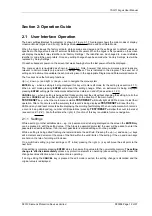
7SG11 Argus User Manual
©2013 Siemens Protection Devices Limited
P20006 Page 21 of 37
4.2.3.3 SEF/REF
Pick-up and Drop-off
For Argus relays with the SEF/REF element fitted then the current setting should be checked for this pole. This
can be achieved in the same manner as the IDMTL/DTL Characteristic Pick-up/Drop-off tests.
Record the results in Table 4-12. Confirm that the measured Pick-up level is within 5% of the set value and that
Drop-off occurs at 95% of the measured Pick-up value.
Timing
The timers used in the SEF/REF mode are operated sequentially. Separate contacts must be configured for timer
1 and timer 2 in order that operation of each timer is checked.
Set the operating time on timer 1 to the required time and connect a time interval meter to the contact configured
for timer 1. Inject a current at least three times the setting and record the time.
Set the operating time on timer 2 to the required time and connect a time interval meter to the contact configured
for timer 2. Inject a current at least three times the setting and record the time. The operating time is the addition
of time 1 and time 2. Subtract time 1 from time 1+2 to get the operating time for timer 2.
Note that the SEF/REF pole has an additional available timer that is referred to as the lowset delay, this should be
tested if required by the application.
Record the results in Table 4-13 and confirm that the measured delays are within 5% of the set values.
4.2.3.4 Circuit Breaker Fail
To measure the pick up level, temporarily set a status input to operate the external CBF function then invert the
input, this enables the element. The delay time should be set to zero. Inject current and record the pick up level in
Table 4-14.
The 2-stage circuit breaker failure feature should be tested if required by the application. If only one of the stages
is to be used then only CBF delay 1 need be tested.
In order to test both stages of the CBF feature then the two CBF delays should be programmed to operate
separate output contacts other than the main trip output. They should also be programmed with their appropriate
delays and current level setting.
CBF delay 1 is initiated by the main trip output and current above the setting, after timing out it generates a trip
output of its own and also initiates the CBF delay 2 which subsequently generates a final trip output.
Connect the main trip output to start a time interval meter. Connect the output from CBF delay 1 to stop both the
timer and the current source. Inject current of 2x setting into any pole and record the first CBF time delay in Table
4-15.
Connect the CBF delay 1 output to start the time interval meter. Connect the output from CBF delay 2 to stop
both the timer and the current source. Inject current of 2x setting into any pole and record the second CBF time
delay.
Check that the measured delays are within 5% of the set values.
4.2.3.5 Directional Tests
This applies to Argus 2 and Argus 6 relays only
The following tests deal specifically with directional functionality. Note that there are a number of variants of
directional Argus relays with various combinations of directional and non-directional poles. These tests should
only be applied to those poles that are directionalised.
Note also that the directional response for each characteristic (eg IDMTL, highset, etc) is programmable and may
be selected as either Non-directional, Forward, Reverse or TRI-state depending on the requirements of the
scheme. For the following tests the ‘Directional Control’ settings should be set to the required settings.
Directional Polarity Check
This test checks for correct polarity of the directional circuits.
In the Instruments menu display; indication is provided on the output states of the directional elements, i.e.
whether they see forward current, reverse current or neither for each pole. This display is an aid to commissioning
testing. If the Argus is allowed to trip during testing then this display will be interrupted and replaced by the fault
data display screen. If this normal operation interferes with testing then temporarily change the ‘Fault Trigger’
setting so that no fault indication will be given if the Argus trips.






























